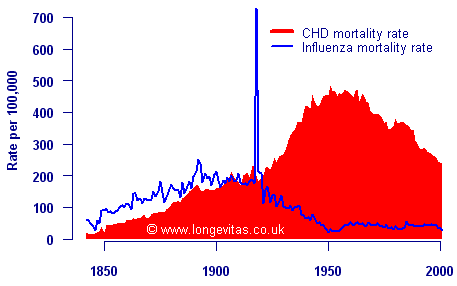Influenza and coronary heart disease
Every good statistician knows that correlation does not imply causation. Just because two things appear linked does not mean they are. However, with historical data we often don't have the luxury of carrying out controlled, scientific experiments to see if A really does cause B.
One particularly interesting example is the possible link between influenza and coronary heart-disease (CHD) mortality. The following chart is derived from data from the Massachusetts Department of Public Health Registry of Vital Records and Statistics, and is inspired by a similar chart by Azambuja and Levins (2007):

While we know that correlation does not imply causation, there does seem to be a rising incidence of CHD along with the rising incidence of influenza in the 19th century. Particularly dramatic is the apparent "tsunami" of CHD mortality unleashed by the Spanish Influenza pandemic of 1918-1919. Some researchers speculate that this led to a "damaged generation", whose excess CHD mortality became ever more apparent as they aged. However, now that this generation is dying out, and since influenza mortality is now also very low, the "CHD epidemic" appears to be petering out. It is for this reason that Azambuja posed the seemingly paradoxical question in a title of another paper: Is the 1918 Influenza Pandemic Over?
The chart presents some fundamental problems for actuaries trying to predict future mortality rates. For example, an actuary of 1917 could not have been expected to predict the Spanish Influenza pandemic, still less any long-term increase in mortality due to a seemingly unrelated cause. Equally, an actuary of 1950 could not have predicted the following steep fall in CHD mortality rates. Can actuaries of the early 21st century be any less sure that something similarly bizarre doesn't lie just around the corner?
The above figure also illustrates a particular problem in trying to project mortality by cause of death. If there is a link between influenza and CHD, for example, then any cause-of-death projection model will have to be quite complicated to reproduce a pattern like that above. And how can a cause-of-death projection model deal with undiscovered linkages between other causes?


Comments
Dear Dr. Richards
I am working on that explanations and I believe that I am almost there! But to explaining the past shall prove much more easier than predicting the future!
Regards,
Maria Inês Azambuja
Add new comment